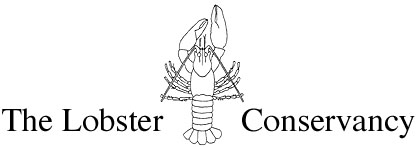
P.O. Box 235, Friendship, ME 04547 (207) 832-8224 www.lobsters.org

P.O. Box 235, Friendship, ME 04547 (207) 832-8224 www.lobsters.org
August 13, 1999
Dear Volunteers and Friends of The Lobster Conservancy,
July was another busy month for all of us involved with The Lobster Conservancy. Here's all the news that's fit to print!News from the Board of Directors
Friendship Lobster Laboratory
Bubba Thompson — builder of the house, shed and lobster pound at the Friendship Lobster Laboratory — visited the island in July and gave much appreciated advice on the care and maintenance of our property. Not only does Bubba know the property intimately as a craftsman, he also knows it affectionately as the place where he grew up. We learned a great deal and look forward to working with Bubba in the future.
The laboratory received many visitors in July and every visitor was a helper. Thanks to Deanna Jaroche, Julia Deitz, John Reichnach, Don Rich, and George and Scott Baker for helping to scrape barnacles and other fouling organisms to free the flow through the dam. Diana Barshaw Rich and Don Rich also spent many hours snorkeling in the pound and started a species list describing which organisms inhabit which parts of the pound. The species are diverse — particularly where the flow rate is greatest at the waterfall. Don found a juvenile lobster living under one of the metal plates near the gate. Diane tagged and released her.
Naoto and Susan from Talmage Solar Engineering, Inc. came by on July 15 for a site visit to develop our solar design. George Baker donated and installed a propane refrigerator in the shed. Thank you!
Diane will be giving a presentation in Friendship on the fascinating life cycle of lobsters on Tuesday, August 17 (see Upcoming Events).
Research News
Harpswell
This month marks Diane's 7th July sampling at Lowell's Cove where juvenile lobsters continue to be found in the intertidal zone at the highest recorded densities. Fortunately, Diane had helpers assisting her during each morning's tide. Zachary Lindsey (Gene and Althea Alexander's grandson) assisted Diane on July 12 (starting at 3:15am), 13, and 14. Douglas Moore joined Zack and Diane on the 14th, and Sara Ellis helped out on the 15th.
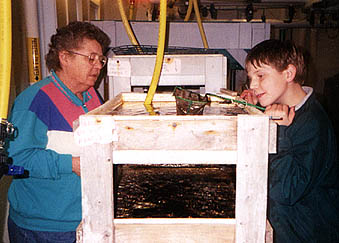
Althea Alexander and Zachary Lindsey visiting the lobster lab at the Maine Department of Marine Resources. Photo by Diane Cowan
Postlarval settlement took place during July's spring low tides — the smallest lobsters measured 5 mm in carapace length (CL). Diane and crew found 4th, 5th and 6th stagers — especially along the west side of Barleyfield Point. A total of 255 lobsters were captured, of which approximately 240 were tagged. Thirty-seven previously tagged individuals were recaptured.
Zack and Diane were especially pleased that they were visiting Gene and Althea at this particular time. It meant that they got to spend some of Gene's last moments with him. The morning of July 13th, they all had coffee together, then Gene went out on his last fishing trip. He died on his boat. We're sure that's the way he would have wanted it — given a choice. So long, Kid — we're gonna miss ya.
Other sites in Harpswell continued to be productive spots this July. At Pott's Point, Kristine Osolin and Jeff Polley found 4 juvenile lobsters (24-35 mm CL) actually 5 lobsters if you include the slippery one that got away!. As they only found one lobster here last month, densities appear to be increasing as summer progresses.
On Jaquish Island, Ned and Kathy Osolin found 9 lobsters (25-58 mm CL). For those of you who have been wondering what the bright orange organism is that you sometimes find encrusting rocks, it is a colonial tunicate commonly called orange sheath tunicate. The scientific name is Botrylloides.
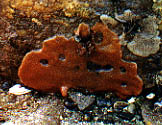
Orange sheath tunicate, Botrylloides spp., a colonial organism commonly found attached to rocks in the lower intertidal zone. Photo by Kathy Osolin
In Cundy's Harbor, Amy Watson uncovered 7 lobsters (19-44 mm CL). This was only half as many as she found on her transect in June, a somewhat surprising trend. It will be interesting to see what August brings.
In Little Harbor, Corie Bibber found 14 lobsters (11-38 mm CL) along her transect. She found 2 others (19 and 32 mm CL) under some irresistible rocks.
At Gun Point, Chris Heinig covered two transects totaling 35 square meters. He found 13 lobsters (19-45 mm CL) along his transects. As the tide raced in, Chris scrambled to turn 5 random rocks and found another 5 lobsters (29-45 mm CL). Most of the animals he found were damaged in some way.
New Hampshire and Southern Maine
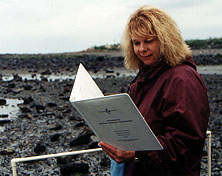 Barb Zulkiewicz (above) was recently trained to monitor lobsters, along with her daughter Jessica Byrne, at Odiorne Point State Park in New Hampshire. Photo by Sara Ellis |
At Odiorne Point State Park, Alan Stewart and Bobbi Costello found 15 lobsters. The sex ratio was heavily skewed toward males (12 M: 3 F), and most lobsters displayed some damage. On July 13, Sara Ellis joined Al to train Barb Zulkiewicz, a new volunteer in New Hampshire. Barb and her daughter Jessica Byrne will be taking over the site at Odiorne, while veteran volunteers Al and Bobbi scout for other intertidal lobster nursery grounds in New Hampshire and southern Maine. Sara enjoyed the chance to see the site at Odiorne for the first time. Thanks for the hospitality, Al.
On July 18, Al and Bobbi scouted within southern Maine at Fort Foster, Kittery Point. The tide that day was not very low (-0.1 ft), but they did find two lobsters (both 45 mm CL), so they plan to check the area again on a spring low tide. |
Muscongus Bay
On July 14, Sara scouted for juvenile lobsters on the mainland side of Friendship Harbor. She searched along a mud and rock beach near the beginning of Davis Point, just south of the Fishermen's Heritage Lobster Coop. She found 6 lobsters (36-53 mm CL), including a recently molted lobster with a brittle shell. One was very close to molting as its limb buds and tail flesh were dark, blood red.
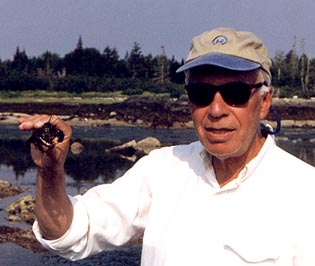 Peter Schwindt traveled to the Friendship Lobster Laboratory on the Patricia S. then took Diane scouting for intertidal lobsters on Harbor and Hall Islands. Photo by Diane Cowan |
Several days later, Sara turned her attention back to Friendship Long Island. She and Julia Dietz, a summer intern at the Island Institute helping out with various TLC activities, set up a transect south of the lobster pound, on the rocky beach below George Baker's house. Diane had successfully found lobsters in this vicinity on a scouting trip in June. After a false start in one location, they found a more productive site as the tide came in. They found 4 lobsters (44-59 mm CL), two of which were very clearly premolt. With special permission from the Department of Marine Resources, one lobster was temporarily captured for display on Friendship Day (see Outreach).
Peter Schwindt moored his boat off the Friendship Lobster Laboratory's wharf for an overnight stay on July 15. The next morning, he and Diane took a boat trip for a scouting mission on Harbor and Hall Islands. They searched amongst the loose rocks between Harbor and Hall — recording their location with the help of Peter's hand-held GPS unit. Peter and Diane found a total of 11 lobsters ranging from 23 to 60 mm in carapace length. Five of the lobsters were female.
|
Penobscot Bay
In Penobscot Bay, juvenile lobsters were found at Allen Island, Port Clyde, South Thomaston, Vinalhaven, Isle au Haut, and Matinicus, i.e., the western and outer regions of the bay. But folks in the more inner regions such as Rockport, Castine, Deer Isle, Islesboro, and North Haven were stymied once again.

Greg Kibitz (left) and Brian Dalton have been faithfully monitoring their site in Glen Cove, Rockport despite a lack of lobsters. Photo by Sara Ellis
In Rockport, Greg Kibitz and Brian Dalton completed a full transect at their Glen Cove site taking careful note of the extensive marine life they found.
In Castine Harbor, Elaine Gardner followed a lead from a local diver who had seen small lobsters (approximately 2 inches long) 20 ft off a dock just north of the yacht club. Although she didn't find any lobsters this time, such local knowledge has been helpful in many instances in the past. So keep up the good sleuthing work, Elaine.
On nearby Deer Isle, Ken and Terry Bovee flipped about 90 rocks at two different sites (Sand Beach and Sylvester's Cove) in search of lobsters. While they didn't find any, they did get to see many, many crabs! They plan to continue surveying both sites.
Once again, no lobsters were found at any of the 4 sites on Islesboro. Ed and Alice Girvin found many other marine creatures at their site on Grindle Point, as did Bob Congdon and Jim Mitchell at Sprague Cove. Steve and Jairus Miller carefully checked 10 quadrats at Loranus Cove, then looked randomly along the line for lobsters thereafter. The next day Steve went to Town Beach to take a look.
On North Haven, teacher Luke Howell took out 5 students from the Community School at 5:00 in the morning. Although they didn't find any lobsters, Luke reports that the students began to see the scientific importance of the number "zero". The North Haven team was excited to find the diversity of other kinds of marine life, such as sculpins, crabs, and rock gunnels.
On Monhegan, Peter and Raquel Boehmer checked out Pebble Beach on July 15 as a potential site. The next day they went back to their original transect site at Fish Beach, only to find it so covered with periwinkles that it was hardly recognizable. No lobsters were found at either site, but they plan to continue checking Fish Beach at the lowest monthly tides.
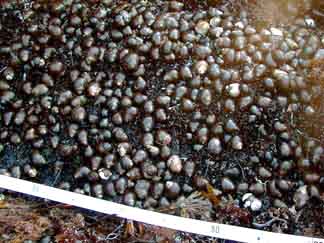
On Monhegan, Peter and Raquel Boehmer's monitoring site at Fish Beach was so covered with periwinkles that it was hardly recognizable. Photo by Peter Boehmer
On Matinicus, Eva, Eric and Emily Murray brought Grace Booth (age 8) along to monitor their transect in Condon Cove, where they found just one lobster this July. They found empty claws from three or four other juveniles. Let's hope those were just molt shells and not something's dinner.
On Allen Island, Michael Wall found 17 lobsters (28-57 mm CL). He noted that the lobsters seemed to be in better shape than the previous month. This may be related to the fact that many of the lobsters had recently molted, allowing them to regenerate some of their appendages.
At Drift Inn Beach, Port Clyde, Jane Roundy and Julie Wortman found 17 lobsters (25-43 CL), tying Allen Island for the highest number of lobsters found in Pen Bay this month.
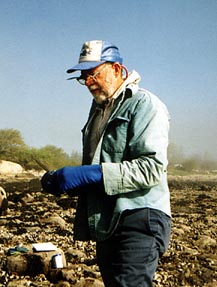
Lobsterman Alfred Petterson has been monitoring intertidal lobsters at Waterman Beach along with Leslie Fuller and Annette Naegel. Photo by Sara Ellis
Leslie Fuller and lobsterman Alfred Petterson found 4 lobsters at Waterman's Beach in South Thomaston, Waterman's Beach . They were able to capture and measure 3 of them (34-57 mm CL), while the fourth only teased them from beneath a huge rock where they saw a LARGE pair of claws being withdrawn into a crevice.
 |
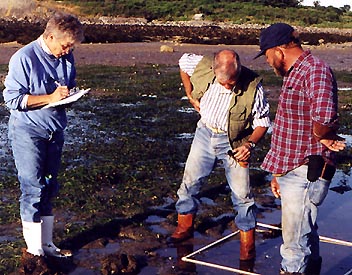 On Vinalhaven, volunteers Ginger and John Van Ness and lobsterman Eric Davis (right) have been studying lobsters burrowed in eel grass beds. They have developed their own daring technique for extracting lobsters from U-shaped burrows. Photos by Julia Dietz |
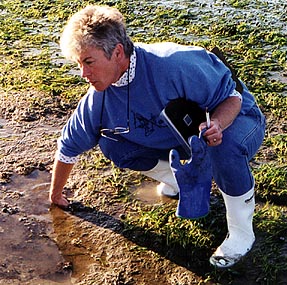 |
Vinalhaven volunteers John and Ginger Van Ness and Eric Davis were accompanied by Julia Dietz as they collected data at their site on Lanes Island. They conducted a partial survey at their regular rocky intertidal site and found 8 lobsters (27-70 mm). Then they went back to explore an eel grass area where they had found lobsters last month--a very exciting discovery. Taking care not to sink too far into the mud, they walked around feeling for extra-soft areas and looking for burrow entrances. When they found a burrow, one brave soul stuck their hand in the hole and felt around the tunnel to see if anyone was home. Often this would chase the lobster out its "back door" where someone was waiting for it, or the lobster could be grabbed and pulled out. Amazingly, nobody's fingers got pinched in the process! Almost all of the lobsters in eel grass were larger than those found at the rocky site (5 lobsters, 50 —72 mm CL). |
Outreach
On Friendship Day, July 31, Diane and Sara had an opportunity to introduce themselves and The Lobster Conservancy to the people of Friendship, while sharing in a wonderful community event. They set up a display on Main Street in front of the office describing TLC's research, volunteer, and educational programs. A popular part of the display was the juvenile lobster collected from Friendship Long Island. This lobster had molted during its brief captivity, thus we were able to show people the lobster's complete molt shell for comparison with the new larger size of the lobster. This lobster has since been tagged and released back on Friendship Long Island.
They also set up a marine touch tank in a wading pool to let kids and adults get up close and personal with many marine animals and plants found right here in our local waters. Thanks go to Jean Beale for providing the wading pool, and to Julia Dietz and John Reichnach for helping set it up. We also thank the Fishermen's Heritage Lobster Coop for providing two large lobsters for the touch tank.
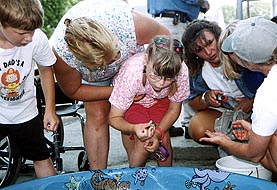 |
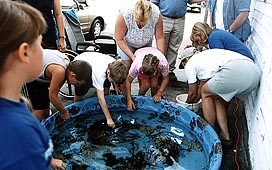 |
Several visitors to the display bought hats sporting The Lobster Conservancy's logo. Hat sales help to support our research, and a portion of the proceeds collected on Friendship Day were contributed to the Friendship Ambulance Fund.
Upcoming Events
If you'd like to learn more about the fascinating biology and behavior of lobsters, Diane will be giving a presentation entitled "The Lobster Life Cycle: From Egg to Plate" on August 17th. The talk will begin at 7 pm in the Hahn Community Center, 31 Main St., Friendship.
Yours in TLC and Friendship,
Sara Ellis, Executive Director and Diane Cowan, Senior Scientist